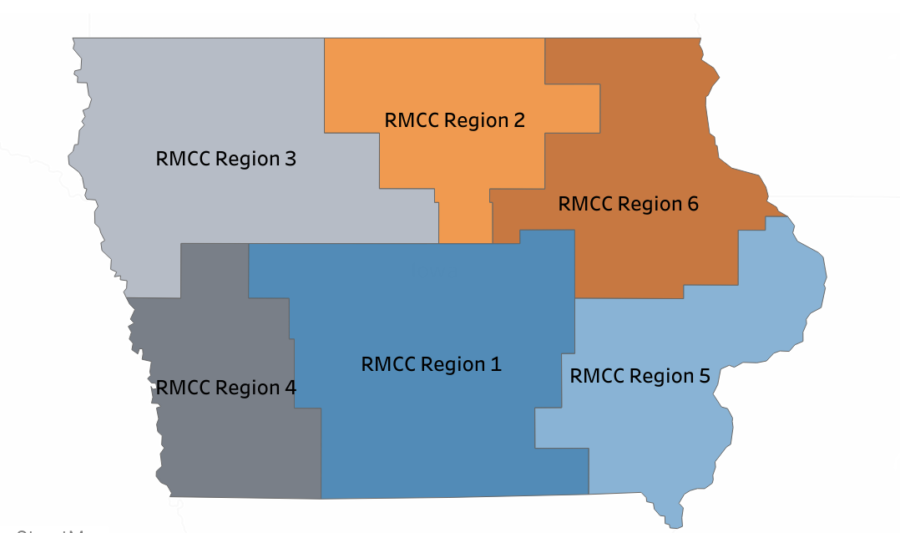Black and Latino Iowans are disproportionately impacted by the pandemic
A map outlining the Regional Medical Coordination Center’s regions of Iowa. This map and more information about COVID-19 can be found at coronavirus.iowa.gov.
April 26, 2020
Editor’s note: A previous version of this article inaccurately quoted the mayor of Waterloo, Quentin Hart. The article has since been corrected. The Daily regrets this error.
Nonwhite Iowans have tested positive for COVID-19 at disproportionately higher rates than white Iowans, according to data published by the state.
This follows a national trend of black Americans dying at higher rates compared to other Americans from the disease caused by the new coronavirus.
Officials from the Iowa Department of Public Health (IDPH) said it is partially linked to job occupations, such as food manufacturing plants, but the data that shows the disparities are still being analyzed.
“And I think […] we know that there’s a higher incidence of underlying health conditions that make these particular populations more susceptible to more serious COVID complications,” said Sarah Reisetter, the deputy director of the IDPH during one of Gov. Kim Reynolds’ news conferences.
As of April 26, there have been 5,476 total confirmed cases of COVID-19 in Iowa and 118 deaths. Latino and Hispanic Iowans of any race account for 5.6 percent of the state population, according to Census Bureau data, while people self-identifying as being of Hispanic or Latino ethnicity account for 22.7 percent of positive cases of COVID-19 in Iowa. Black or African American Iowans account for 13.1 percent of the total confirmed cases while making up about 3 percent of the state population.
Infectious disease physician and public health researcher Megan Srinivas, who practices at the Fort Dodge Community Health Center, said there are a lot of factors that play into the ethnic disparities being seen not only in Iowa, but also across the nation.
Srinivas said anyone with preexisting health conditions, such as diabetes, asthma, obesity and heart disease, are more likely to be at risk of contracting the illness and are at risk for more severe symptoms from it.
“Unfortunately, with a lot of the communities we are seeing being hit, they do have higher rates of heart disease, diabetes, obesity than the average population,” Srinivas said. “That alone already makes them more vulnerable.”
Srinivas agreed with the IDPH deputy directors’ analysis of the higher susceptibility among certain communities, she added it is also important to look at the social determinants of health. Many of the people in these communities being disproportionately impacted are essential workers who are unable to work from home, with jobs in places such as food processing plants, putting them at higher risk.
A Tyson plant in Black Hawk County was recently closed after elected officials and the health board for Black Hawk County pushed Tyson and Gov. Kim Reynolds to suspend its operations. The Waterloo pork processing plant is one of the largest in the nation.
Waterloo, which is located in Black Hawk County, has the highest proportion of African American residents of any city in Iowa, at 15.5 percent. Black Hawk County went from 35 cases earlier in the week to 714 cases as of the latest update.
“It may [be] at a point where we or the company may have not been ahead of it, but it doesn’t mean we can’t get a hold of it,” said Quentin Hart, the mayor of Waterloo. “The virus doesn’t discriminate based upon who you are, and when people are in close proximity within shared working spaces, the potential can be there for a quicker spread.”
Hart said now that the plant is closed they can focus on getting everyone tested.
Srinivas said these disparities existed before the outbreak and a lot of the affected people do not have access to health care on a regular basis.
“Now that we are seeing this pandemic [take] hold of any gaps in care or in anybody who might be more vulnerable than others, we are really finding that is preying upon these disparities and is widening the gap,” Srinivas said.
Srinivas said these disparities are a commentary on the social determinants of health that impact the health care system but also are a commentary on the health care system as a whole.
To fight this pandemic, Srinivas said there are measures that can be taken to protect essential workers, such as staggered shifts and lunch breaks and ensuring all employees have proper protective gear. Srinivas said this needs to be enacted by public health leaders.
“It is really the leaders who are supposed to be fighting this pandemic that need to take the reins in settings like this and issue preventive protocols,” Srinivas said.

















